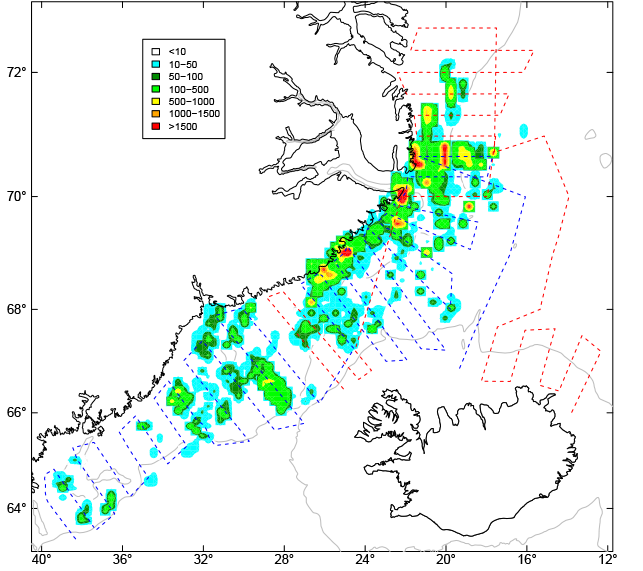- EU projects
- Research
- Fish tagging
- Lumpfish research
- Oceanography
- Seabed mapping
- Arnarfjörður
- Drekasvæði
- Ísafjarðardjúp
- Jökulbanki
- Jökuldjúp
- Kolbeinseyjarhryggur and adjacent area
- Kolluáll
- Langanesgrunn
- Látragrunn
- Nesdjúp
- Reykjaneshryggur and adjacent area
- Selvogsbanki
- South of Selvogsbanki
- South of Skeiðarárdjúp
- South of Skerjadjúp
- Southeast of Lónsdjúp
- Southwest of Jökuldjúp
- Suðausturmið
- Suðurdjúp
- Vesturdjúp
- East of Reykjaneshryggur
- Vestfjardarmid
- Seal research
- Whale Research
- Advice
- About
Reduction in capelin catch advice
04. October 2022
 The survey tracks of RV Árni Friðriksson (red) and Tarajoq (blue) in August to September 2022 and the distribution of capelin.
The survey tracks of RV Árni Friðriksson (red) and Tarajoq (blue) in August to September 2022 and the distribution of capelin.
The Marine and Freshwater Research Institute (MFRI) advises that capelin catches in 2022/2023 should be no more than 218 400 tonnes. This intermediate advice replaces initial advice of 400 000 tonnes that was based on the estimate of immature abundance from the autumn survey in 2021. The intermediate advice will be replaced with final advice to be given based on the results of the surveys in January–February like stated in the harvest control rule for the stock.
The revised advice is based on results from acoustic measurements on the capelin stock by RV Árni Friðriksson (Icelandic) and RV Tarajoq (Greenlandic) conducted during the period 27 August to 29 September 2022. It is based on extensive coverage during mostly good weather conditions. Sea ice limited the coverage towards north, but it is deemed unlikely that capelin were present in the skipped area. The survey estimate had low coefficient of variation (CV) as the capelin was relatively evenly distributed and the density of transects was high in areas of high mature capelin abundance.
The total biomass came to 1.1 million tonnes of which the spawning stock amounted to 763 000 tonnes. The estimated amount of juveniles was 41 billion but more than 50 billion is required to provide non-zero preliminary advice according to the HCR for the fishing season 2023/24. The results of the juvenile measurements will be presented within ICES, which will give advice on TAC for capelin for the fishing season 2023/24 later in this autumn.
